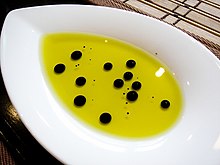Phase separation: Difference between revisions
talk about spinodal |
mention upper critical solution temperature and copy nicotine-water example from lower critical solution temperature |
||
| Line 9: | Line 9: | ||
A common form of spontaneous phase separation is termed [[spinodal decomposition]]; it is described by the [[Cahn–Hilliard equation]]. Regions of a [[phase diagram]] in which phase separation occurs are called [[miscibility gap]]s. There are two boundary curves of note: the [[binodal|binodal coexistence curve]] and the [[spinodal|spinodal curve]]. On one side of the binodal, mixtures are absolutely stable. In between the binodal and the spinodal, mixtures may be [[metastable]]: staying mixed (or unmixed) absent some large disturbance. The region beyond the spinodal curve is absolutely unstable, and (if starting from a mixed state) will spontaneously phase-separate. |
A common form of spontaneous phase separation is termed [[spinodal decomposition]]; it is described by the [[Cahn–Hilliard equation]]. Regions of a [[phase diagram]] in which phase separation occurs are called [[miscibility gap]]s. There are two boundary curves of note: the [[binodal|binodal coexistence curve]] and the [[spinodal|spinodal curve]]. On one side of the binodal, mixtures are absolutely stable. In between the binodal and the spinodal, mixtures may be [[metastable]]: staying mixed (or unmixed) absent some large disturbance. The region beyond the spinodal curve is absolutely unstable, and (if starting from a mixed state) will spontaneously phase-separate. |
||
The [[upper critical solution temperature]] (UCST) and the [[lower critical solution temperature]] (LCST) are two [[critical temperature]]s, above which or below which the components of a mixture are miscible in all proportions. It is rare for systems to have both, but some exist: the [[nicotine]]-water system has an LCST of 61 °C, and also a UCST of 210 °C at pressures high enough for liquid water to exist at that temperature. The components are therefore miscible in all proportions below 61 °C and above 210 °C (at high pressure), and partially miscible in the interval from 61 to 210 °C.<ref name=Atkins>P.W. Atkins and J. de Paula, "Atkins' Physical Chemistry" (8th edn, W.H. Freeman 2006) pp. 186-7</ref><ref name="White">M. A. White, ''Properties of Materials'' (Oxford University Press 1999) p. 175</ref> |
|||
== Phase separation in cold gases == |
== Phase separation in cold gases == |
||
Revision as of 18:07, 19 May 2024



Phase separation is the creation of two distinct phases from a single homogeneous mixture.[1] The most common type of phase separation is between two immiscible liquids, such as oil and water. This type of phase separation is known as liquid-liquid equilibrium. Colloids are formed by phase separation, though not all phase separations forms colloids - for example oil and water can form separated layers under gravity rather than remaining as microscopic droplets in suspension.
A common form of spontaneous phase separation is termed spinodal decomposition; it is described by the Cahn–Hilliard equation. Regions of a phase diagram in which phase separation occurs are called miscibility gaps. There are two boundary curves of note: the binodal coexistence curve and the spinodal curve. On one side of the binodal, mixtures are absolutely stable. In between the binodal and the spinodal, mixtures may be metastable: staying mixed (or unmixed) absent some large disturbance. The region beyond the spinodal curve is absolutely unstable, and (if starting from a mixed state) will spontaneously phase-separate.
The upper critical solution temperature (UCST) and the lower critical solution temperature (LCST) are two critical temperatures, above which or below which the components of a mixture are miscible in all proportions. It is rare for systems to have both, but some exist: the nicotine-water system has an LCST of 61 °C, and also a UCST of 210 °C at pressures high enough for liquid water to exist at that temperature. The components are therefore miscible in all proportions below 61 °C and above 210 °C (at high pressure), and partially miscible in the interval from 61 to 210 °C.[2][3]
Phase separation in cold gases
A mixture of two helium isotopes (helium-3 and helium-4) in a certain range of temperatures and concentrations separates into parts. The initial mix of the two isotopes spontaneously separates into -rich and -rich regions.[4] Phase separation also exists in ultracold gas systems.[5] It has been shown experimentally in a two-component ultracold Fermi gas case.[6][7] The phase separation can compete with other phenomena as vortex lattice formation or an exotic Fulde-Ferrell-Larkin-Ovchinnikov phase.[8]
See also
References
- ^ Nic M, Jirat J, Kosata B (1997). "Phase separation". In McNaught AD, Wilkinson A, Jenkins A (eds.). IUPAC Compendium of Chemical Terminology (the "Gold Book") (2nd ed.). Oxford: Blackwell Scientific Publications. doi:10.1351/goldbook.P04534. ISBN 0-9678550-9-8.
- ^ P.W. Atkins and J. de Paula, "Atkins' Physical Chemistry" (8th edn, W.H. Freeman 2006) pp. 186-7
- ^ M. A. White, Properties of Materials (Oxford University Press 1999) p. 175
- ^ Pobell, Frank (2007). Matter and methods at low temperatures (3rd rev. and expanded ed.). Berlin: Springer. ISBN 978-3-540-46356-6. OCLC 122268227.
- ^ Carlson, J.; Reddy, Sanjay (2005-08-02). "Asymmetric Two-Component Fermion Systems in Strong Coupling". Physical Review Letters. 95 (6): 060401. arXiv:cond-mat/0503256. Bibcode:2005PhRvL..95f0401C. doi:10.1103/PhysRevLett.95.060401. PMID 16090928. S2CID 448402.
- ^ Shin, Y.; Zwierlein, M. W.; Schunck, C. H.; Schirotzek, A.; Ketterle, W. (2006-07-18). "Observation of Phase Separation in a Strongly Interacting Imbalanced Fermi Gas". Physical Review Letters. 97 (3): 030401. arXiv:cond-mat/0606432. Bibcode:2006PhRvL..97c0401S. doi:10.1103/PhysRevLett.97.030401. PMID 16907486. S2CID 11323402.
- ^ Zwierlein, Martin W.; Schirotzek, André; Schunck, Christian H.; Ketterle, Wolfgang (2006-01-27). "Fermionic Superfluidity with Imbalanced Spin Populations". Science. 311 (5760): 492–496. arXiv:cond-mat/0511197. Bibcode:2006Sci...311..492Z. doi:10.1126/science.1122318. ISSN 0036-8075. PMID 16373535. S2CID 13801977.
- ^ Kopyciński, Jakub; Pudelko, Wojciech R.; Wlazłowski, Gabriel (2021-11-23). "Vortex lattice in spin-imbalanced unitary Fermi gas". Physical Review A. 104 (5): 053322. arXiv:2109.00427. Bibcode:2021PhRvA.104e3322K. doi:10.1103/PhysRevA.104.053322. S2CID 237372963.
Further reading
- Khabibullaev PK, Saidov A (April 2013). Phase Separation in Soft Matter Physics: Micellar Solutions, Microemulsions, Critical Phenomena. Berlin Heidelberg: Springer. ISBN 978-3-662-09278-1.


